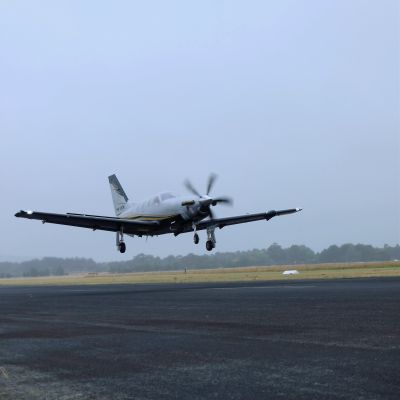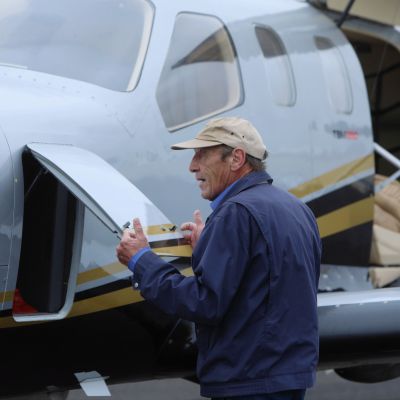Unlocking the future of aviation in Ballarat
The City of Ballarat’s Draft Ballarat Airport Strategy and Master Plan will guide how the Ballarat community can benefit from our airport for decades to come. From potential passenger travel to expanding economic opportunities for business, the Ballarat Airport holds a key to future growth and development in the region.

Imagine this: in the not-too-distant future you need to fly interstate, but instead of using Melbourne Airport or Avalon, you catch a plane from Ballarat. Forget the long drive, the expensive parking spot far from the terminal or battling crowds in a sprawling metropolitan airport.
In this scenario you park at the front of Ballarat Airport in Mitchell Park or have someone drop you off. In a few minutes you are checked in and ready to board your flight.
With fresh investment at Ballarat Airport, this could be how Ballarat and western Victorians fly in the future, saving residents time and money and opening new opportunities for local business.
Consulting for the future
In the coming weeks, the City of Ballarat will seek community feedback on a Draft Ballarat Airport Strategy and Master Plan 2024.
Ballarat Airport Commercial Manager Jonathan Willsher says the draft plan will set out the potential role, uses and growth opportunities for the airport in the next 20 years. One of those opportunities is passenger flights, with Ballarat one of the few centres in the top 50 Australian cities without passenger and air freight services.
“We’re in a transport shadow,” Jonathan says.
“We don't have those direct connections to other population centres of Australia. We are the outlier in that we are still reliant on Melbourne.
“Currently, local businesses and their clients lose a day of productivity sending people to and from Ballarat to Melbourne Airport.”
Strong demand for air travel
As part of the draft plan, the City of Ballarat has commissioned a comprehensive passenger catchment study to measure how many Ballarat and western Victoria residents travel by air and which airport they use.
The results show current demand for air travel is strong, with an average 1150 people travelling daily from the region to Melbourne Airport, peaking at almost 1600 air travellers during school holidays.
“As an example, if we were to capture just 20 per cent of the average daily travellers from our region, this would result in approximately 20 full Bombardier
Dash 8-Q400 (80 seats) flights a week outbound from Ballarat,” Jonathan says.
Notably, this doesn’t account for any growth that would come from introducing the service and allowing residents to make trips not available now.
It is important to acknowledge Ballarat’s role as the regional centre for Western Victoria and the transport access it can provide to the whole of regional Western Victoria.
Study reveals demand for aviation investment
In November 2023, City of Ballarat began consultation with community and industry on the Ballarat Airport Strategy and Master Plan, including drop-in sessions and surveys.
A community survey found 71 per cent of respondents said an airline service to Ballarat would be beneficial, while reduced road travel was identified as a key benefit for 35 per cent of respondents.
An industry survey found that 82 per cent of industry respondents said an airline service would benefit their organisation, while almost two thirds use aviation within their supply chain or operations every week.
Unlocking economic opportunities
Air services can create significant economic benefits for Ballarat, opening the potential for visitors to access the region’s world class tourist destinations without transiting through Melbourne, while other businesses will reap cost savings and have more access to new markets.
Ballarat Airport Operations Manager John Hartigan says the airport was built as a training base for the Royal Australian Air Force at the beginning of the Second World War. After the RAAF left in 1961, it’s been owned and operated by the Shire of Ballarat and then the City of Ballarat.
Today, it is located next to Ballarat’s key industrial precinct the Ballarat West Employment Zone (BWEZ), with new airside lots currently being developed.
“It’s a vital asset for the Ballarat community and home to more than 10 aviation businesses, emergency services and community clubs,” John says.
The aviation industry has strong supply chain links and future development of the airport could lead to associated aviation industry growth and investment in Ballarat.
“The strategy and master plan will guide how the Ballarat community can benefit from our airport for decades to come,” John says.
Join the conversation
Development of the draft master plan began with an initial phase of community engagement in November 2023.
It builds on previous master plans and completed works at the airport, including a project to lengthen the north-south runway to 1800 metres which was jointly funded with $3.8 million from the Federal Government and $5 million from the City of Ballarat.
The project will ultimately allow for larger commercial, aerial firefighting and emergency services aircraft and increase opportunities to attract new aviation business.
View the Draft Ballarat Airport Strategy and Master Plan on mySay
The next phase of consultation will begin mid-year.





